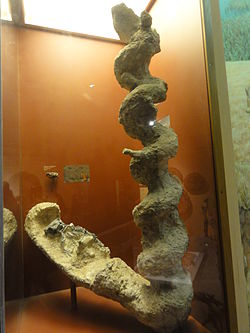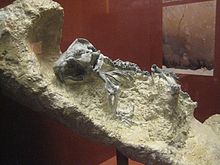- Palaeocastor
-
Palaeocastor
Temporal range: Late Oligocene to Early Miocene
Palaeocastor burrow Scientific classification Kingdom: Animalia Phylum: Chordata Class: Mammalia Order: Rodentia Family: Castoridae Subfamily: †Palaeocastorinae Genus: †Palaeocastor
Leidy, 1869Species See Text Palaeocastor ('prehistoric beaver') is an extinct genus of beaver that lived in the North American Badlands during the late Oligocene period.
Contents
Habitat
This creature made corkscrew-shaped burrows and tunnels. Like many early castorids, Palaeocastor was predominantly a burrowing animal instead of an aquatic animal. Fossil evidence suggests that they may have lived in family groups like modern beavers and employed a k reproductive strategy instead of the normal r-strategy of most rodents.
"Devil's Corkscrews"
The discovery of Palaeocastor sprung from the discovery of Devil's Corkscrews in the plains of Sioux County, Nebraska, as a tree-sized, screw-like underground formation. The basic form of it is an elongate spiral of hardened earth material that inserts into the soil as deep as 3 meters. These puzzling structure came first to the notice of science through Dr. E. H. Barbour of the University of Nebraska around Harrison, Nebraska, in 1891 and 1892.[1] Then he described it as giant freshwater sponges. This identification was influenced by the surroundings where the "screws" were situated:the deposits in which they occur were laid down in immense freshwater lakes in the Miocene Epoch, 20 million years ago. Also for a while, people tended to believe the spiral forms are a curious type of extinct vegetation, although many remain skeptical as well.
In 1893, Dr. Thomas Barbour proposed that the Devil's Corkscrew were the burrows of a large rodent, and Latinized the name to the ichnofossil name Daimonhelix or Daimonelix or Daemonelix (all these spellings are found) and classified them by shape and size.
The dispute on its real identity ceased when a fossilized beaver was discovered in one of them. And the scratches which previously misinterpreted as claw marks are also strong evidence of the existence of Palaeocastor in contrast to the modern castor.[2]
They excavated their burrows with their incisors, not their claws.[3]
References
- ^[dead link]
- ^ Stokes, W.Lee (1982). Essentials of Earth History 4th Edition. Prentice-Hall, Inc.. pp. 127–129. ISBN 0132858908.
- ^ "Traces of burrows". Hooper Virtual Natural History Museum. http://hoopermuseum.earthsci.carleton.ca/Burrowsite/fossil4.htm. Retrieved 9 April 2011.
External links
This article about a prehistoric rodent is a stub. You can help Wikipedia by expanding it.



